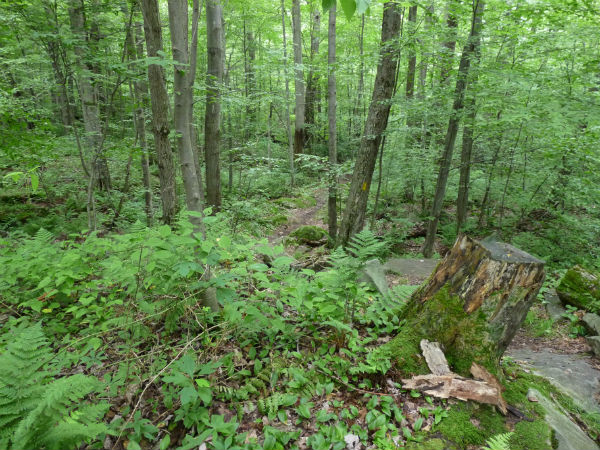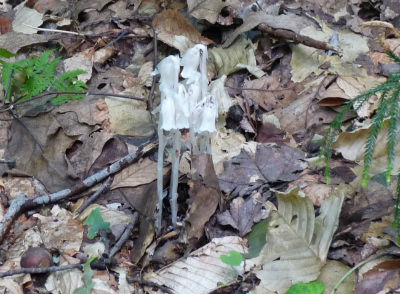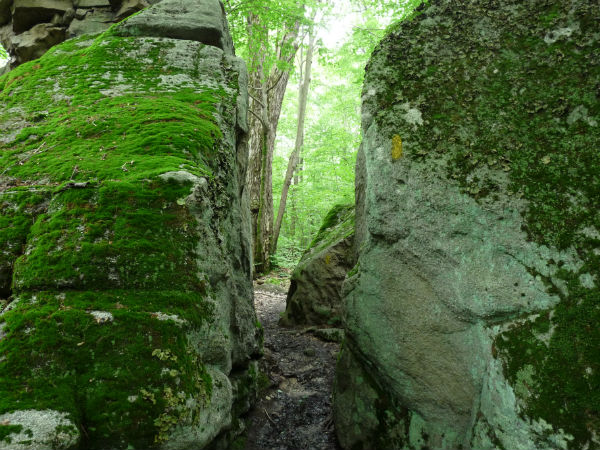Deborah and I took advantage of the brief break in the on-going summer rains and headed down to the Laurel Highlands Trail for a walk in the woods. We drove to the trail crossing at Route 30 and headed south for a short, “in-and-out” hike. There were no other cars in the parking area and only one other registration card in the trail drop box, so we knew that we would have the woods to ourselves.
 There are several overall impressions of this part of the trail. The first is the overwhelming color of green. The tree canopy (dominated by oaks and birches), the mid-story (dominated by striped maples and witch hazel, and the understory of rhododendron, cat briar, and ferns (mostly cinnamon fern, interrupted fern, hay scented fern, and evergreen wood fern) surround you with so many rich colored leaves and fronds that that the air itself seems to take on a green color. The second is the moisture. The leaves are wet and pushing aside low branches along the trail showers you with a fine spray of water, the soil on the trail is wet and full of tracks (more on this later), and in places the trail itself is a shallow rill of water flowing downhill to the loud, rushing streams that you eventually walk over on split-log foot bridges. And finally, the nature of the trail itself: so rocky and irregular that you have to walk along with your eyes on your feet to find safe spots for each step. You need to stop occasionally to look around or you might miss the surrounding woods completely.
There are several overall impressions of this part of the trail. The first is the overwhelming color of green. The tree canopy (dominated by oaks and birches), the mid-story (dominated by striped maples and witch hazel, and the understory of rhododendron, cat briar, and ferns (mostly cinnamon fern, interrupted fern, hay scented fern, and evergreen wood fern) surround you with so many rich colored leaves and fronds that that the air itself seems to take on a green color. The second is the moisture. The leaves are wet and pushing aside low branches along the trail showers you with a fine spray of water, the soil on the trail is wet and full of tracks (more on this later), and in places the trail itself is a shallow rill of water flowing downhill to the loud, rushing streams that you eventually walk over on split-log foot bridges. And finally, the nature of the trail itself: so rocky and irregular that you have to walk along with your eyes on your feet to find safe spots for each step. You need to stop occasionally to look around or you might miss the surrounding woods completely.
We saw some interesting tracks in the mud of the trail: a few human-boot marks, lots of white-tailed deer, and even a couple of black bear tracks. The edges of the bear tracks were sharp and crisp, so we assumed that they were fairly fresh. We could picture a black bear ambling along the trail earlier in the day, and, so, we kept up a continuous level of conversation while we walked to let any nearby bears know that we were in the area. Seeing a bear would be very exciting but coming on one unannounced might be too extreme an experience for us (and the bear).
 All along the trail were patches of Indian pipe (Monotropa uniflora). Indian pipe is not an uncommon plant in these woods, but I cannot remember seeing so many stems so tightly packed together. The nearly continuous summer rains must have triggered a mass emergence of the flower stems from its extensive, underground root system.
All along the trail were patches of Indian pipe (Monotropa uniflora). Indian pipe is not an uncommon plant in these woods, but I cannot remember seeing so many stems so tightly packed together. The nearly continuous summer rains must have triggered a mass emergence of the flower stems from its extensive, underground root system.
Indian pipe is also called “corpse plant” and “ghost flower” reflecting its pale, waxy coloration and conspicuous lack of the green, chlorophyll pigment. This lack of chlorophyll is further indicative of the unusual, non-photosynthetic lifestyle of this plant. Instead of relying on green plant photosynthesis, this species utilizes its vast network of roots and associated mycorrhizal fungi to gain nutrients and energy products from the roots of surrounding living plants (thus functioning as an parasite). Further, these roots and fungi also gain nutrients and energy from the decaying organic materials in its soil habitat (which puts M. uniflora also into a saprotrophic (“decomposer”) ecological role).
Indian pipe has a single, white, waxy stem that is 3 to 9 inches long and 0.75 to 1.0 inches in diameter. It has no leaves (which is logical since it does not photosynthesize). Scaly bracts are found in place of its vestigial leaves. At the bent terminus of the stem there is a single (rarely double) bell-shaped, white to pink-tinted flower. The stems and flowers arise form a fibrous root system any time between the late spring and early fall. The flowers are pollinated by small bees. After pollination, the flower turns upright and forms a seed capsule. After the tiny seeds mature, they are dispersed through the forest ecosystem by the wind. After the seeds are released the above ground flower and stem blacken and wither away.
As I said, it is a very good year for Indian pipes!
There were not many birds visible or audible on the trail. A few wood thrushes echoed their flute-like songs and a few chipping sparrows and chickadees rustled and tittered at us as we walked by. There was an occasional woodpecker cackle (a northern flicker?) and a mysterious, sharp chirping call possibly from a well hidden flycatcher.
 After about 0.8 miles the trail winds through a set of large, sandstone boulders. Gaps between the rocks along the sides of the trail look like perfect, potential bear dens so we talk a bit louder and even sing some “hello bear” songs. The tall surrounding walls of the sandstone are covered with flat green and brown paper-like lichens (called “smooth rock tripe”) and the tops of the rocks are covered with rhododendrons. It is an iconic, sub-section of the Laurel Highlands Trail!
After about 0.8 miles the trail winds through a set of large, sandstone boulders. Gaps between the rocks along the sides of the trail look like perfect, potential bear dens so we talk a bit louder and even sing some “hello bear” songs. The tall surrounding walls of the sandstone are covered with flat green and brown paper-like lichens (called “smooth rock tripe”) and the tops of the rocks are covered with rhododendrons. It is an iconic, sub-section of the Laurel Highlands Trail!
We walk about 3 miles down to the ravine of Spruce Run. The creek, though is very full of runoff water and has flooded the entire ravine bottom. We hike back up onto the ridge and have a snack and then walk on back to the car. Crossing one of the small creeks on the way back we see a patch of bright red bee balm just upstream. The reds of the flowers glow intensely in the dark green light of the woods. How could we not have seen this on our way past earlier? How much else did we miss along the way?
